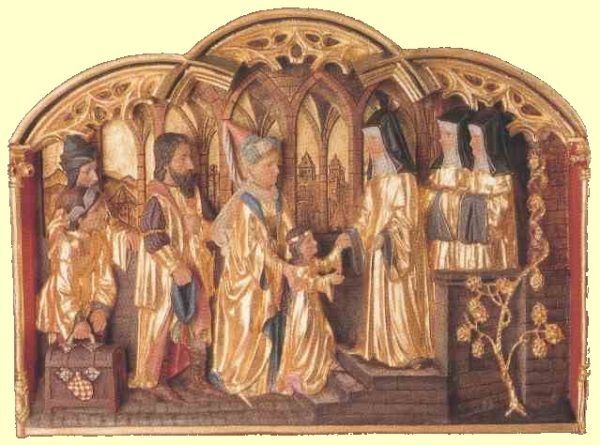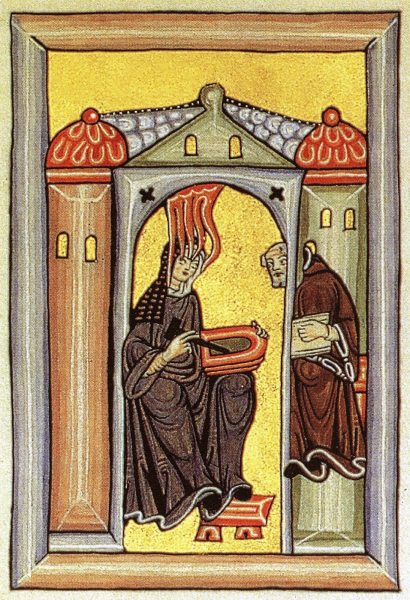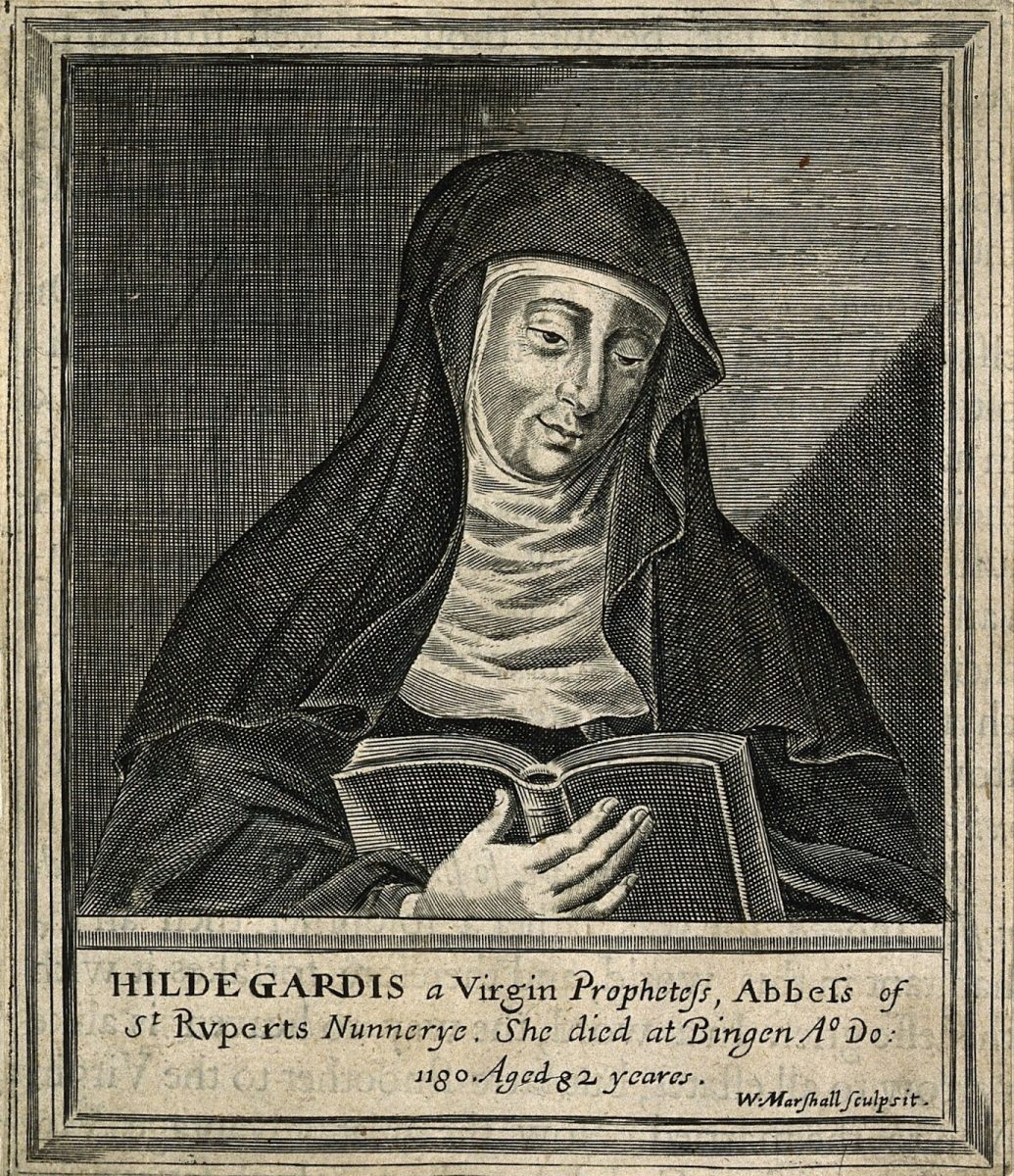In the serene stillness of the Disibodenberg monastery, young Hildegard of Bingen paused, her daily chores momentarily forgotten. The air around her seemed to thrum with an ethereal energy, a sensation both unfamiliar and deeply profound. It was in this moment of quiet solitude that she first heard them — whispers, not of this world, carrying messages of divine insight. These were not the voices of her fellow nuns but something far more mystical. Hildegard, known later for her visionary experiences, stood there transfixed, her heart pounding with both trepidation and awe. This encounter marked the beginning of a spiritual odyssey for Hildegard, one that would eventually lead her to challenge the boundaries of her era with theological insights, musical compositions, and naturalistic writings. The voices, once a source of private contemplation, would inspire a legacy that resonates through the centuries.
Born in the summer of 1098 into a noble family near Mainz in the municipality of Bermersheim, Germany, Hildegard’s journey was extraordinary, marked by visionary experiences, intellectual prowess, and an unyielding spirit that defied the constraints of society. In an era when religious piety was a cornerstone of social life, Hildegard’s parents made a significant decision when she was just eight years old: to dedicate her as a tithe to the church. This early consecration marked the beginning of a lifelong commitment to spiritual service. Hildegard was placed under the tutelage of Jutta of Sponheim, a revered anchoress, at the Benedictine monastery of Disibodenberg. Within those hallowed walls, Hildegard’s education spanned the gamut from theology to the natural sciences, laying the foundation for her later works.

What set Hildegard apart, however, were her visions: ethereal experiences that began in early childhood. Unlike her contemporaries, Hildegard did not initially share these celestial encounters, keeping them a closely guarded secret. It was not until 1141, at the age of 42, that a pivotal vision compelled her to break her silence. She described this experience as being “enveloped by the light of God,” a profound moment that led her to pen her first theological work, Scivias (in English, Know the Ways of the Lord). This monumental endeavor, which took a decade to complete, catapulted Hildegard into the spiritual limelight, garnering recognition from the Church and beyond.
Upon the death of Jutta in 1136, Hildegard’s spiritual and administrative prowess came to the fore as she assumed the role of magistra. Her influence and the burgeoning number of her followers necessitated the establishment of a new convent at Rupertsberg in 1150, and later at Eibingen. These foundations were not mere expansions but powerful statements of female autonomy and leadership within the Church.
Hildegard’s impact was not confined to the spiritual realm. Her extensive correspondence with popes, emperors, and other luminaries of her era is a testament to her far-reaching influence. She was unafraid to voice her criticisms of church practices, leveraging her prophetic authority. Her letters, imbued with spiritual insight, philosophical depth, and, at times, cautious admonitions, reveal a woman deeply engaged with the religious and political dynamics of her time.
Beyond her visionary and administrative capacities, Hildegard was a prolific writer and thinker. Her works delve into varied subjects, from the intricacies of human nature to the mysteries of the cosmos. Her theological perspectives were groundbreaking, particularly her concept of “viriditas,” or the greening power of God, a metaphor for spiritual and physical vitality. This idea reflects a deeply ecological understanding, connecting the divine with the natural world in a manner that was ahead of her time.
Hildegard stands out not only as a mystic and theologian, but also as a composer whose music has transcended time. Her works offer an intriguing glimpse into the musical world of the Middle Ages, a period whose music remains hardly known.
In her collection “Symphonia Armonie Celestium Revelationum,’ Hildegard brings to life a range of liturgical themes, from saints’ feasts to the Virgin Mary, encapsulating a spectrum of religious emotions. The melodies, characterized by their soaring arches and fluidity, reflect a deep understanding of the human voice’s capabilities. Hildegard’s musical language is not just about notes and rhythms; it’s a journey into the realms of divine ecstasy.
The “Ordo Virtutum’ stands as a singular masterpiece in the history of medieval music. This morality play, featuring a cast of virtues and the soul, is a compelling exploration of the human struggle between good and evil. The devil, the only non-singing character, represents the discordance of sin, contrasting sharply with the harmonious virtues. Hildegard’s insight into using music as a narrative and spiritual tool is evident in this work.
Hildegard’s music is marked by its use of soaring melodic contours, unusual for the traditionally more restrained Gregorian chant. Her compositions often feature large intervals, which create a sense of drama and emotional intensity. This melodic boldness was a reflection of her visionary experiences, where she often described seeing a “living light” that imbued her with knowledge.

Furthermore, her lyrics, rich in metaphorical and symbolic language, draw deeply from her theological insights and mystical visions. Hildegard’s texts are not mere liturgical recitations but poetic explorations of spiritual themes. Her use of imagery from the natural world, the cosmos, and the divine realm adds layers of meaning to her compositions.
Hildegard’s influence extended far beyond the boundaries of her convent in Rupertsberg; it permeated the realms of theology, music, medicine, and philosophy. Her visionary experiences, once a source of personal trepidation, became the wellspring of her vast intellectual output, proving that the boundaries between the divine and the mundane are permeable and that insight can flow from the celestial to the earthly plane.
Moreover, Hildegard’s life challenged the boundaries of what it meant to be a woman in medieval Europe. In a time when women were often relegated to the margins of intellectual and spiritual life, Hildegard commanded respect and authority. Her voice, resonant and unwavering, spoke not just to the people of her time, but echoed through the ages, inspiring those who seek to push beyond the confines of their societal roles.
The legacy of Hildegard of Bingen is a mosaic of groundbreaking achievements, each piece a testament to her extraordinary ability to transform boundaries. Her visions, music, and writings continue to inspire and provoke, inviting us to explore the depths of our own potential. Hildegard’s life was a journey of transcendent exploration, a beacon that illuminates the path for those who dare to venture beyond the known, into the realms of spiritual and intellectual discovery.
In contemplating the life of Hildegard, one is reminded of the endless possibilities that lie within the human spirit. Her story is a clarion call to all who seek to transcend the ordinary, to push against the boundaries of convention, and to explore the uncharted territories of mind and spirit.
Hildegard’s life was a journey of transcendent exploration, a beacon that illuminates the path for those who dare to venture beyond the known, into the realms of spiritual and intellectual discovery.

